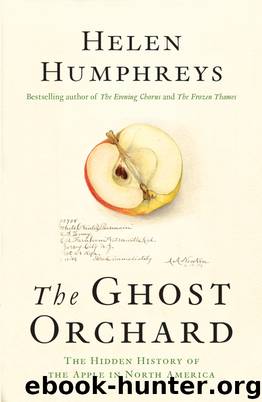The Ghost Orchard by Helen Humphreys

Author:Helen Humphreys
Language: eng
Format: epub
Publisher: HarperCollins Canada
Published: 2017-07-26T04:00:00+00:00
When Frost returned to America, he set about planting his last orchard near his writing cabin in Ripton. He began having discussions about the orchard with a local nursery the previous December, but the apple varieties weren’t finalized and grafted onto the wild trees until June 1957.
The nursery in Shelburne, Vermont, worked with the renowned heritage apple enthusiast Ira Glackens (also a painter and writer, and the son of the realist painter William Glackens) to get Frost the apples he wanted. His desired varieties included Red Astrachan, Porter, Sweet Bough, Sops of Wine, Montreal Peach, Red Van Buren, Cole’s Quince, Gravenstein, Jefferis and St. Edmund’s Russet.19 He had wanted two trees each of all those varieties, except for the Gravenstein and Jefferis, of which he wanted only one. But the varieties available at the time from Glackens were fewer in number, and the trees that Frost eventually selected for his orchard included just six varieties—Sweet Bough, Red Astrachan, Cole’s Quince, Jefferis, Lowland Raspberry and Porter.20 There was no White Winter Pearmain in the mix, but it had become a less popular apple by Frost’s time. Refrigeration had undermined the usefulness of winter apples, much as the camera made the watercolour artist redundant.
The Sweet Bough is an early nineteenth-century apple of American origin. It is medium to large in size and has pale yellow skin and white flesh. Not a good keeper, it is best eaten fresh and has a crisp honey flavour. It has been called the best-tasting early sweet apple. It ripens at the end of July or early August.
The Red Astrachan is another apple ripening in August. It is of Russian origin and was introduced into North America in the early nineteenth century. It was a very popular New England apple in Frost’s time, although it is now hard to find. Also not a good keeper, it is best cooked and is said to make the best jelly of all the apples. It is a medium apple and yellow in colour, with streaks sometimes so numerous that it can appear to be solid red.
Cole’s Quince is a yellow ribbed apple with grainy flesh that, when fully ripe in August, has the taste of quince to it. This large apple is used primarily for cooking and does not store well. It is an old Maine variety and was discovered there in 1806.
Jefferis was a variety once popular with home orchardists because it ripened progressively, a few apples at a time, over a period of weeks beginning in mid-September. It is a fresh-eating apple and also a good keeper. A small to medium yellow apple with thick, translucent skin and a blush on one side, it has a taste of pear to it. It came from Pennsylvania in the 1840s.
The Lowland Raspberry is a medium yellow apple with light crimson marbling. It is of Russian origin and is a hardy, sweet-tasting dessert apple. It’s also known as the Liveland Raspberry and gets its name from the former Livland (or Livonia) province of Russia, which is now Lithuania.
Download
This site does not store any files on its server. We only index and link to content provided by other sites. Please contact the content providers to delete copyright contents if any and email us, we'll remove relevant links or contents immediately.
| Anthropology | Archaeology |
| Philosophy | Politics & Government |
| Social Sciences | Sociology |
| Women's Studies |
The Leavers by Lisa Ko(6460)
Born to Run: by Christopher McDougall(6251)
iGen by Jean M. Twenge(4693)
Sapiens by Yuval Noah Harari(4528)
The Kite Runner by Khaled Hosseini(4415)
Spare by Prince Harry The Duke of Sussex(4188)
Bullshit Jobs by David Graeber(3172)
Livewired by David Eagleman(3113)
Goodbye Paradise(2949)
Never by Ken Follett(2872)
A Dictionary of Sociology by Unknown(2516)
Harry Potter 4 - Harry Potter and The Goblet of Fire by J.K.Rowling(2413)
The Club by A.L. Brooks(2350)
People of the Earth: An Introduction to World Prehistory by Dr. Brian Fagan & Nadia Durrani(2345)
The Social Psychology of Inequality by Unknown(2304)
Machine Learning at Scale with H2O by Gregory Keys | David Whiting(2264)
Harry Potter and the Order of the Phoenix (5) by J.K. Rowling(2224)
0041152001443424520 .pdf by Unknown(2214)
Harry Potter and the Deathly Hallows (7) by J.K. Rowling(2213)
